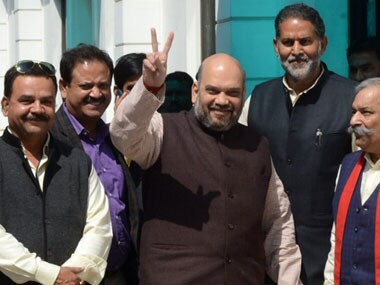It’s settled now beyond a doubt that the road to Delhi passes through Uttar Pradesh. The more leisurely its pace in Uttar Pradesh, the greater the spoils at the Centre. [caption id=“attachment_1517231” align=“alignleft” width=“380”]  Amit Shah. AFP[/caption] The Bharatiya Janata Party’s best-ever performance and the first ever single party majority for a non-Congress party in an Indian general election in 67 years of Independence is on account of Uttar Pradesh. Here’s four quick statistics that put the startling Uttar Pradesh verdict in perspective. One quarter. Seventy-three. That is the BJP tally, including one from Apna Dal. Just how do you make sense of this utterly incredible number? Seventy-three out of Uttar Pradesh’s 80 seats is many things to the Bharatiya Janata Party. It is a 700 percent increase in its UP tally since the 2009 election. It is also 20-odd seats in excess of the very tough target the party had set for itself and for Amit Shah when the BJP general secretary was despatched to the state to handle the campaign there. It is the BJP’s best-ever showing in UP, better by far than the 57 seats it won in 1998. But more than anything else, 73 constitutes one quarter of all of the Bharatiya Janata Party’s parliamentarians in Lok Sabha. This brings to the centrestage of the Indian development debate the state of Uttar Pradesh, which has sent to Parliament several Prime Ministers but remains at the bottom of socio-economic indicators and has little infrastructural development to speak of. The state’s electorate has spoken in unison at least once before in the recent past, in the Assembly election of 2012, which was won comprehensively by the Samajwadi Party with a young, urbane Akhilesh Yadav making a strong pitch for a different kind of politics, for development. Akhilesh rode that aspirational vote to a comfortable victory in 2012, but the Samajwadi Party government has since slid downhill rapidly, now deeply discredited over its handling of communal conflagrations and political goondaism in the state. Seven. That’s the number of non-BJP MPs in the country’s largest state. Two are the Gandhis, the Congress president and vice-president, possibly redfaced over Rahul’s unconvincing margin of 79,000-odd votes, down from 3 lakh-odd. The remaining five are Samajwadi Party members, also all family members of the SP chief Mulayam Singh Yadav. Mulayam himself was leading in Mainpuri by over 3 lakh votes and by a smaller margin in Azamgarh. Nephew Dharmendra Yadav was leading in Badaun. Daughter-in-law Dimple Yadav was leading in Kannauj and another nephew Akshay Yadav from Firozabad. That’s seven seats for dynasty, but those dynasties stand discredited too, managing to protect their own seats but comprehensively voted out everywhere else. That is a resounding message from UP’s voters, one the Congress and SP will remember for a very long time. Zero. That is Mayawati’s tally in Uttar Pradesh, not just a shock vanquishment but squarely placing a troubling question on the future of the Bahujan Samaj Party and of Dalit politics. In 2004 and 2009, the BSP won 24.6 and 27.4 percent of the vote share. BSP ran a low-key campaign that got little media attention, but exit polls showed the BSP finishing with 10 to 14 percent of the vote. The final numbers are awaited, but an educated guess is that behenji finished with somewhat less than what the polls projected. The Dalits have given the country the message as the rest of the state’s voters – caste politics is limiting, Dalits are unwilling to be shackled by the constraints of caste while casting a vote. Two That’s the number of constituencies in Uttar Pradesh where Muslim are in excess of 40 percent of the population. And in both, Moradabad as well as Rampur, BJP candidates were comfortably ahead. In addition, there are 25 seats in eastern and western UP where the population of Muslims ranges from 20 percent to 40 percent: Aligarh, Amroha, Aonla, Badaun, Baghpat, Bahraich, Barabanki, Bareilly, Bulandshahr, Domariyaganj, Gautam BUddha Nagar, Gonda, Kairana, Kaiserganj, Kushi Nagar, Lucknow, Meerut, Muzaffarnagar, Nagina, Pilibhit, Saharanpur, Sambhal, Sant Kabir Nagar, Shrawasti, Sitapur. All of these with the exception of one (Badaun, which was won by SP) were won by BJP or had BJP candidates in leads at 6.30 pm. Just how this came to be—voting patterns, tactical voting, the vote share of the SP/BSP/Congress—remain to be analysed. But undeniably, that number provides some extra food for thought. Has the Muslim vote just been rendered irrelevant by the caste math of the RSS and Amit Shah?
Four statistics you should know if you want to understand just how the Bharatiya Janata Party managed to pull off the near-impossible result of 73 out of 80 seats.
Advertisement
End of Article


)
)
)
)
)
)
)
)
)



